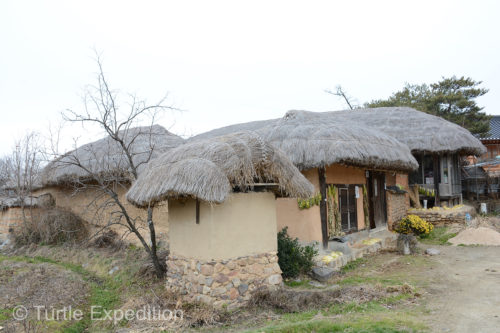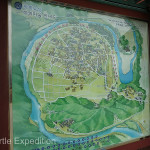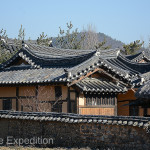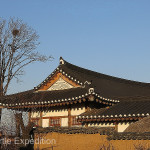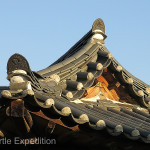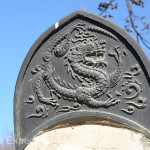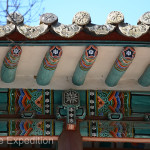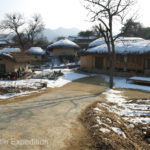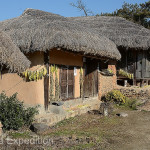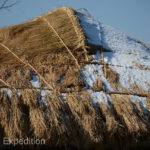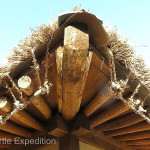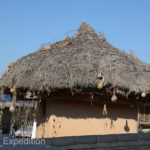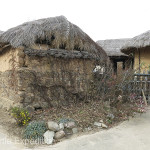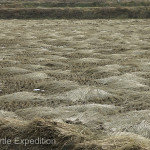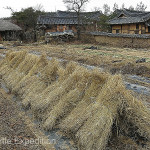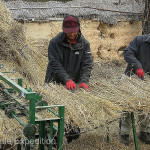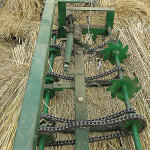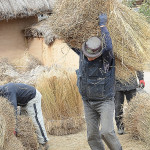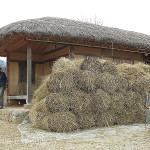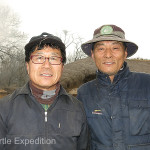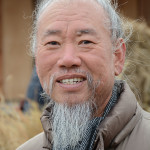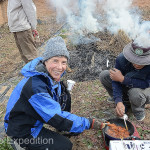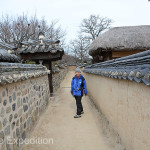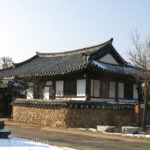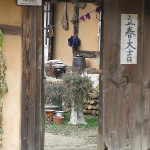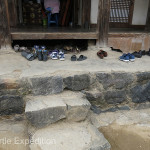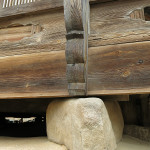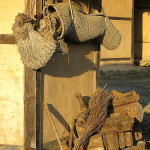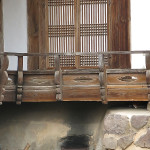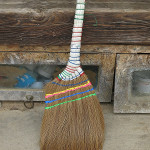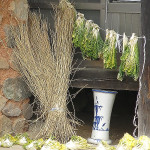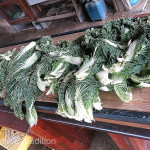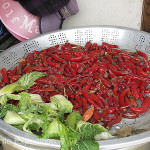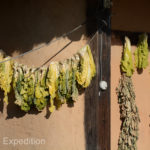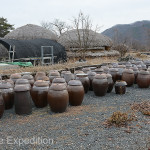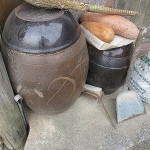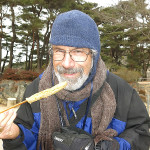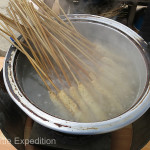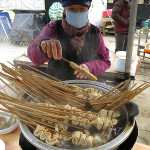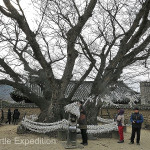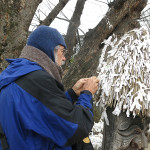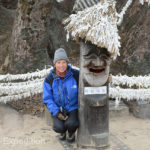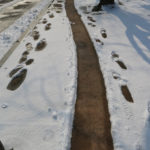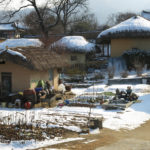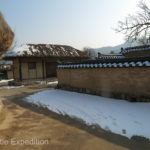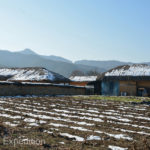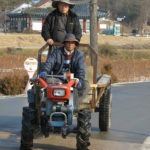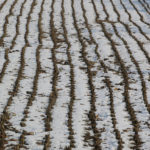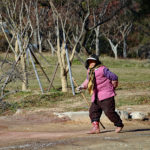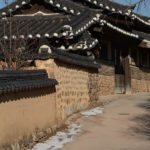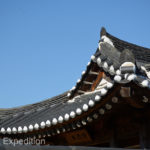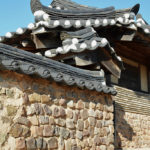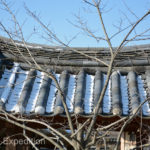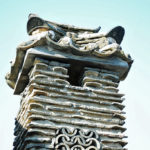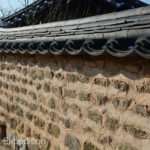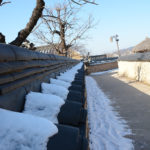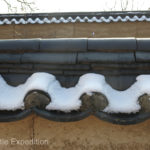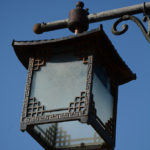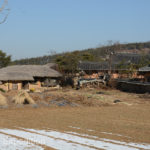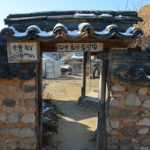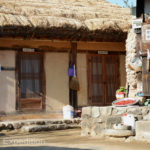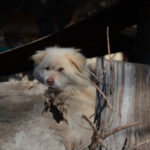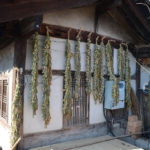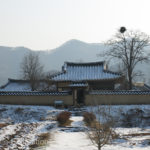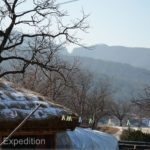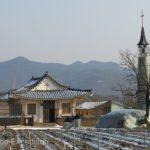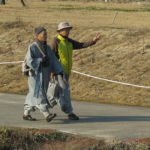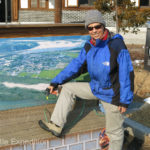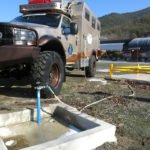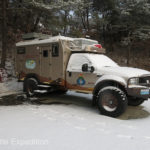South Korea #4 – Hahoe Folk Village – December 2014
While traveling through South Korea we were constantly reminded of just how modern this country is. Sometimes it was hard to find anything that would be ancient or historic, so we were delighted to stumble upon the Hahoe Folk Village. Located near Andong, Gyeongsangbuk-do, it was established in the 16th century during the Joseon Dynasty. It has been a one-clan community (the Ryu family) since that time. The village maintains old architectural styles that have been lost elsewhere because of rapid modernization and development in South Korea. Aristocratic tile-roofed residences and thatched-roof servants’ homes allowed us to step back in time. It is listed as a UNESCO World Heritage site.
Rice Straw Thatched Roofs
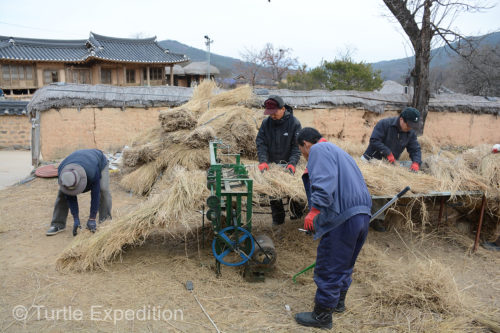
Locals were using an interesting rice straw stitching machine to create long rolls of roofing materials.
One of the more interesting things about Hahoe village was the extensive use of rice straw for many of the roofs. Rice is one of the main food crops here, but it seemed almost as important for the continued use of the thatched roofs which must be redone periodically. Once the rice has been harvested, the straw is gathered and stacked in the fields to dry. As we walked around the village through the narrow dirt streets we happened upon a group of men using an interesting sewing machine to gather the rice straw into bundles. As friendly as Koreans are, they invited us to join them for their midday meal and get a closer look at how they were preparing the straw for later use.
And more Kimchi Production
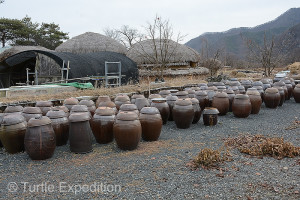
Sort of a mixture of fermented cabbage, chilies and fish, kimchi is stored in clay pots. No Korean meal is complete without kimchi.
Peeking into open doors of private homes, however a private home can be when it’s part of UNESCO world heritage site, we were fascinated by some of the old traditions. Persimmons, cabbage and chilies were being dried and preparations were under way for making kimchi, a staple dish in Korea. We stopped by one dry goods store where they were selling an interesting snack, sort of like an egg omelet or crape on a stick cooked in a seaweed broth and basted with a soy sauce. It was quite tasty on this chilly day.
The Goddess Samsin resides in the 600-year old Zelkova Tree
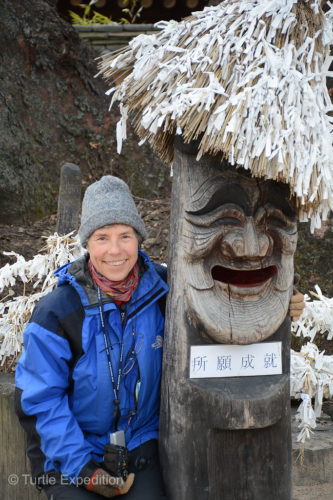
Monika wrote her wish to the Goddess Samsin who resides in the 600-year old Zelkova Tree behind her.
The Nakdong River flows around Hahoe in an S shape, which gave the village its name: “ha” means river and “hoe” means turning around. Some say, it resembles a lotus flower floating on water. On the highest point in town we found the 600-year old zelkova tree. The Goddess Samsin who resides in the tree is said be in charge of pregnancy and prosperity. You can make a wish by writing it on a small piece of the paper and then when the paper is burned on January 15th, your wish will come true. We asked for a safe trip to Japan and back to California, and time to celebrate Gary’s birthday in Mexico. More on that later.
- The village is surrounded by the River Nakdong, making it an ideal place to live. Some say it resembles a lotus flower.
- The attractive sweeping tile roofs have been maintained for centuries in the historic Village of Hahoe.
- The ornate end caps added to the beauty of the tile roofs.
- The end caps must be important in protecting the houses from bad spirits.
- In the nearby Confucius Temple we were impressed with the beautiful detailed painting and the ornate end caps on the tiles.
- We wandered through Hahoe and couldn’t stop taking photos of this picturesque traditional village.
- The straw thatched roofs, traditionally said to be servants’ quarters, were part of what gave the Ryu clan village its historic appeal.
- These rice straw roofs are very carefully tied down.
- Here they used gourd as weights.
- This house might get a new roof this winter.
- Once the annual crop of rice has been harvested the straw is carefully dried and bundled in the fields.
- The rice straw is bundled and dries in the fields.
- We happened upon a group of men using a unique sewing machine to stitch the rice straw together for later use on the roofs of the village.
- This rice straw sewing machine was quite ingenious.
- Several men were working together to process the rice straw bundles into sticked mats.
- The stitched rice straw mats were rolled and stacked until future use.
- Though they may grow tired of tourists walking through their village, the Koreans we met were always excited to meet people from United States and Switzerland.
- Mr. Kim Jong-heung, the famous wood carver in Hahoe, was happy to pose for a picture.
- The guys sewing up rice straw invited us to sample their midday meal, delicious pork in a red pepper sauce.
- As we wandered through the narrow dirt streets of Hahoe we stepped back in time. Little has changed in 600 years.
- Hoping not to invade the locals privacy, we were curious how their courtyards looked like.
- As we had been warned in our Lonely Planet guidebook, Korea is absolutely a shoes-off country. One should always carry some slippers or warm socks.
- Some of the older homes had been built on rock foundations.
- Everywhere we turned, there were new subjects to photograph.
- Winters can be very cold. Heating is still done with coal. The traditional homes had furnaces under the floors for radiant heat.
- A standard tool in every home, we loved the beautiful brooms.
- The whole village seemed to be prepared chilis and cabbage for the making of kimchi, an important traditional dish all over Korea.
- Unfortunately, we never saw the whole kimchi process so we don’t know why they were drying (or freezing?) them at this house.
- Cabbage and chili peppers, two of the ingredients of the famous Kimchi. Every family must have its own secret recipe.
- Sort of a mixture of fermented cabbage, chilies and fish, kimchi is stored in clay pots. No Korean meal is complete without kimchi.
- Monika wished she could have brought one of these pots home – without kimchi!
- Stopping at a small outdoor store, we sampled some interesting snacks on a stick.
- These snacks were quite tasty and warmed us up a bit.
- It was very cold so we all stood a little closer to the hot pots hoping to catch some radiating heat.
- We made a wish to the Goddess Samsin who resides in the 600-year-old zelkova tree.
- We were the only foreigners in town.
- Monika poses with a carved figure in front of the 600-year old Zelkova Tree where the Goddess Samsin resides.
- Looking back, we should have splurged a night in a B&B!
- Hahoe villagers at work. Their traditional life does not stop because of visiting tourists.
- A rice stubble field after a brief snow storm offered an interesting perspective.
- Chilly or not, this old lady was out for a stroll.
- Snow art.
- Open doors were inviting but these were private homes.
- This cute dog was peeking out over the fence.
- We had no idea what was drying on these strings. Maybe the tops of a root vegetable?
- This was obviously a wealthy member of the Pyu clan.
- On the outskirts of Hahoe stood, to our surprise, a Baptist Church.
- Many villagers were dressing in their traditional clothing.
- All roads and paths in Hahoe are dirt so at certain times they can be quite muddy. At the parking lot they provided a sprayer to wash off your boots. How thoughtful.
- Filling our water tank in the winter can be problematic. A cheater hose gave us the connection we needed.
- While camping at the Hahoe visitor parking area, we woke up to a light dusting of snow.



